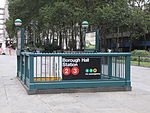Brooklyn Municipal Building
Brooklyn building and structure stubsDowntown BrooklynGovernment buildings in Brooklyn

The Justice Ruth Bader Ginsburg Municipal Building (previously the Brooklyn Municipal Building) was built in 1924. Designed by McKenzie, Voorhees & Gmelin, the construction cost $5,800,000. It is located at 210 Joralemon Street. It contains a branch of the New York City Clerk's office (including a detail of the New York City Marriage Bureau) and branch offices for the Departments of Buildings, Probation, Finance, and Environmental Protection. In July 2012, the Landmark Preservation Commission approved an upgrade to the first few stories and add much commercial signage. In 2016, renovation was done on two cellar levels and two floors.
Excerpt from the Wikipedia article Brooklyn Municipal Building (License: CC BY-SA 3.0, Authors, Images).Brooklyn Municipal Building
Joralemon Street, New York Brooklyn
Geographical coordinates (GPS) Address External links Nearby Places Show on map
Geographical coordinates (GPS)
| Latitude | Longitude |
|---|---|
| N 40.6921 ° | E -73.9905 ° |
Address
Justice Ruth Bader Ginsburg Municipal Building
Joralemon Street 210
11201 New York, Brooklyn
New York, United States
Open on Google Maps






